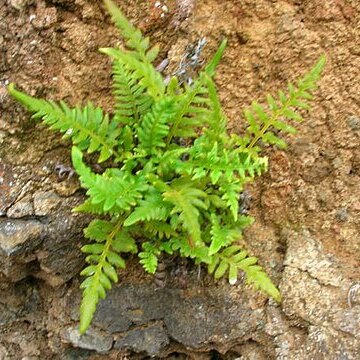Plants perennial [annual], on rock or terrestrial, of small (rarely large) stature . Stems compact to creeping, branched or unbranched, dictyostelic, bearing hairs and/or scales. Leaves monomorphic to dimorphic, circinate or noncircinate in bud . Petioles usually with persistent scales proximally, lacking spines; vascular bundles 1--several, roundish or crescent-shaped in cross section. Blades 1--6-pinnate, without laminar buds . Indument on petioles, rachises, costae, and blades, rarely absent or commonly of hairs, glands, and/or scales, occasionally of white or yellow farina. Veins pinnate or parallel in ultimate segments of blades, simple or forked, free or infrequently anastomosing in complex patterns. Sori borne abaxially on veins, often confluent with age and forming a continuous submarginal band, or sporangia densely covering abaxial surface (acrostichoid); receptacle not or only slightly elevated. Indusia (when present) formed by reflexed, recurved, or revolute leaf margin (false indusium). Sporangia stalk of 2--3 rows of cells; annulus vertical, interrupted by stalk; spores 64 or 32 (rarely 16) per sporangium. Spores all 1 kind, brown, black, or gray (rarely yellow), globose to globose-tetrahedral or trigonal, occasionally with prominent equatorial ridge, trilete, or trigonal, variously ornamented (usually cristate or rugose). Gametophytes green, aboveground, obcordate to reniform, sometimes asymmetric, usually glabrous (glandular-farinose in Notholaena ); archegonia and antheridia borne on abaxial surface, antheridia 3-celled.
Terrestrial, lithophytic, epiphytic or aquatic ferns. Rhizome short-to long-creeping, ascending to erect, with a protostele, solenostele or dictyostele, usually with scales or rigid bristles, rarely only with fine hairs (not Australia); scales concolorous or bicolorous with a darker centre, sometimes with ciliate margin; bristles usually dark. Fronds simple and entire or sagittate (not Australia), 1– to 6-pinnate, tripartite-pedate, or dichotomously forking into narrow segments (not in Australia), sometimes without a stipe; monomorphic or dimorphic, herbaceous to coriaceous, glabrous, glandular, hairy or scaly, occasionally densely so; venation free and forking or anastomosing without free included veinlets. Sori exindusiate, covering much of the abaxial surface (Acrostichum) or elongate, along veins or marginal or intramarginal and usually protected by a recurved lamina margin. Spores monomorphic or rarely (Pteris platyzomopsis) with dimorphic spores, trilete or rarely monolete, globose or tetrahedral, smooth, rugose, tuberculate, echinate, cristate or ridged, with or without a prominent equatorial flange, without chlorophyll.
Aquatic or semi-aquatic annuals or short-lived perennials, floating or rooted, exposed or submerged; roots arising from near the base of the stipe. Rhizome reduced, erect, sparsely scaly. Stipes tufted. Fronds dimorphic; veins anastomosing, without free included veinlets; sterile fronds simple to 3-pinnate, broad, herbaceous, somewhat spongy, glabrous; pinna-sinuses often bearing buds which can give rise to small plantlets; fertile fronds larger than the sterile ones (usually absent from submerged plants), 4-5 (-6)-pinnate in larger fronds; pinna-segments linear; margins recurved, enclosing 1-4 rows of sporangia. Sporangia globose, not grouped into sori but borne singly along the veins, thin-walled, nearly sessile; annulus irregular (±absent in one non-Australian species). Spores 70-150 µm diam., tetrahedral-globose, trilete, ridged, 32 or (not in Australia?) 16 per sporangium; equatorial flange lacking.
Terrestrial heterosporous ferns with a short, condensed rhizome and medullated protostele. Fronds tufted, dimorphic, shortly filiform or pinnate; pinnules with strongly revolute margins. Sporangia borne singly at vein tips, containing either large or small spores; annulus oblique or irregular in position and form and sometimes appearing transverse; indusium absent. Spores globose, trilete to tetrahedral, occasionally with some bilateral and either trilete or monolete, of two sizes with one half the size of the other, occasionally some intermediate; perispore absent. Small spores to 32 per sporangium; larger spores to 16 per sporangium. Gametophytes dioecious: small spores producing filamentous prothalli lacking rhizoids and bearing antheridia; large spores producing spathulate prothalli bearing rhizoids and archegonia, although old prothalli may produce some antheridia.
Terrestrial (including saline and freshwater swamp dwellers) or growing on rocks; rhizome erect or creeping, solenostelic or dictyostelic with basifixed ± entire mostly non-clathrate scales

